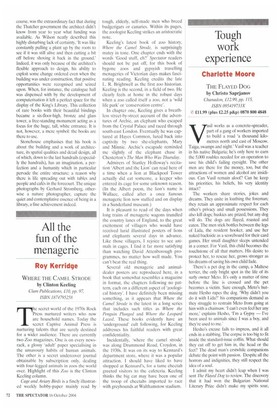All the fun of the menagerie
Roy Kerridge
WHERE THE CAMEL STRODE by Clinton Keeling Clam Publications, £10, pp. 97, ISBN 1874795258 The secret world of the 1970s Rock Press nurtured writers who now are household names. Today the secret Captive Animal Press is nurturing talents that are surely destined for a wider audience. There are currently two Zoo magazines. One is on every newsrack, a glossy 'adult' paper specialising in the unsavoury habits of human animals. The other is a secret undercover journal obtainable by subscription only, dealing with four-legged animals in zoos the world over. Highlight of this Zoo is the Clinton Keeling column.
Cage and Aviary Birds is a finely illustrated weekly hobby-paper mainly read by tough, elderly, self-made men who breed budgerigars or canaries. Within its pages, the zoologist Keeling strikes an aristocratic note.
Keeling's latest book of zoo history, Where the Camel Strode, is surprisingly matey in tone. One chapter ends with the words 'Good stuff, eh?' Spectator readers should not be put off, for this hook of bygone zoos and gypsyish travelling menageries of Victorian days makes fascinating reading. Keeling credits the late L. R. Brightwell as the first zoo historian. Keeling is the second, in a field of two. He clearly feels at home in the robust days when a zoo called itself a zoo, not a 'wild life park' or 'conservation centre'.
In chapter one, Keeling gives a breathless street-by-street account of the adventures of Archie, an elephant who escaped from the Crystal Palace and raced through south-east London. Eventually he was captured at Hayes Common, lured back into captivity by two she-elephants, Mary and Minnie. Archie's escapade reminded me slightly of the elephant chase in Chesterton's The Man Who Was Thursday.
Admirers of Stanley Holloway's recitation 'Albert and the Lion can read here of a time when a lion at Blackpool Tower actually did eat someone, a keeper who entered its cage for some unknown reason. (In the Albert poem, the lion's name is Wallace, called after a once famous menagerie lion now stuffed and on display in a Sunderland museum.) It is pleasant to read of the days when long trains of menagerie wagons trundled the country lanes of England, to the great excitement of villagers who would have received lurid illustrated posters of lions and elephants several days in advance. Like those villagers, I rejoice to see animals in cages. I find it far more satisfying than watching David Attenborough programmes, no matter how well made. You can't beat the real thing.
Several old menagerie and animaldealer posters are reproduced here, in a book that somewhat resembles a magazine in format, the chapters following no pattern, each on a different aspect of 'zoological history'. I have definitely been missing something, as it appears that Where the Camel Strode is the latest in a long series that includes such titles as Where the Penguin Plunged and Where the Leopard Lazed. These books evidently have an 'underground' cult following, for Keeling addresses his faithful readers with great confidentiality.
Incidentally, 'where the camel strode' was along Drummond Road, Croydon, in the 1930s. It was on its way to Kennard's department store, where it was a popular attraction. I should have liked to have shopped at Kennard', for a tame cheetah greeted visitors to the cafeteria. Keeling thinks the big cat may have been one of the troop of cheetahs imported to race with greyhounds at Walthamstow stadium.










































































































 Previous page
Previous page